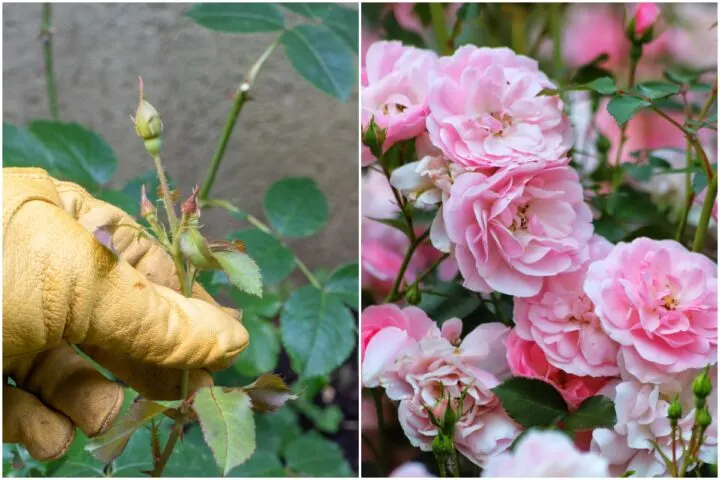In the realm of gardening, deadheading is one of everyone’s least favorite activities. It’s right up there with weeding. When it comes to roses, deadheading often falls in the realm of “Dang it, I knew I forgot to do something” garden tasks.
Whether you’re a seasoned gardener or a novice, understanding the importance of deadheading can make a huge difference in the health, vigor, and beauty of your rose bushes.
Once you understand the why, when and how, you’ll see why it’s so important and rarely forget to do it. However, there is a scenario in which you might not want to deadhead roses, and we’ll discuss why that’s important, too.
The Importance of Deadheading Roses

Roses, renowned for their exquisite blooms and heady fragrance, are the crown jewels of many flower gardens. However, to keep them blooming profusely throughout the season and encourage new growth, deadheading becomes a non-negotiable task. You have to do it.
Deadheading is essentially the removal of spent flowers from the plant.
When you deadhead a plant, you’re redirecting the plant’s energy and resources away from seed production and toward producing more flowers, thereby promoting continuous blooming. You’re basically thwarting every plant’s desire to bloom, drop seeds and call it quits for the season.
If you need more convincing, here are all the reasons why you should be deadheading your roses.
1. Encourages Reblooming

One of the primary reasons for deadheading roses is that it tells the plant to produce more flowers. And who doesn’t want more roses?
When you remove spent blooms, you prevent the formation of rosehips (these are the seed pods). This signals to the plant that, nope, your job isn’t done here; you need to continue producing flowers. This ends up giving you a prolonged blooming period with an abundance of glorious roses.
Deadheading is particularly beneficial for repeat-bloomers like hybrid tea roses, floribundas, and many modern shrub roses like Knock-Outs.
2. Improves Aesthetic Appeal

Look, I’m just going to say it: a well-maintained rose bush with regularly deadheaded blooms looks so much neater and more attractive in the garden. Roses that have bloomed without being deadheaded tend to look scraggly and messy. It’s not a great look among all of your other summer-blooming flowers.
3. Prevents Disease
Deadheading can also contribute to the overall health of your roses by reducing the risk of disease. Spent flowers left on the plant can become breeding grounds for pests and fungal diseases, especially if you get a hot, rainy season.

By deadheading regularly, you’re improving air circulation and allowing more light into the heart of the plant. Both of these reduce the likelihood of common problems such as powdery mildew or botrytis blight taking hold.
An ounce of prevention is worth a pound of dead rose bushes.
How to Deadhead Roses
Deadheading roses is pretty straightforward and is just like it sounds. When done correctly, you can get some pretty impressive results as the plant reblooms.
Here’s a step-by-step guide to help you on your way to becoming a rose-gardening master:
Step 1: Gather Your Tools
Before you begin, gather your tools: a pair of sharp pruning shears or scissors (You did remember to sterilize them, right?) and a bucket or basket for collecting the dead flowers. Use sharp tools to make clean cuts; this minimizes damage to the plant.
You’ll also want a thick pair of gloves to protect your hands. They make special rose-gardening gloves that are more like a gauntlet to protect your forearm from all those thorns, but these are only necessary if you have a large, bushy plant.
Step 2: Identify Spent Flowers

Inspect your rose bush regularly, ideally every few days during the blooming season. Look for flowers that have faded, lost their vibrant color, or begun to wilt. These are the blooms that are ready to be deadheaded.
GO TO PAGE 2 TO CONTINUE READING




